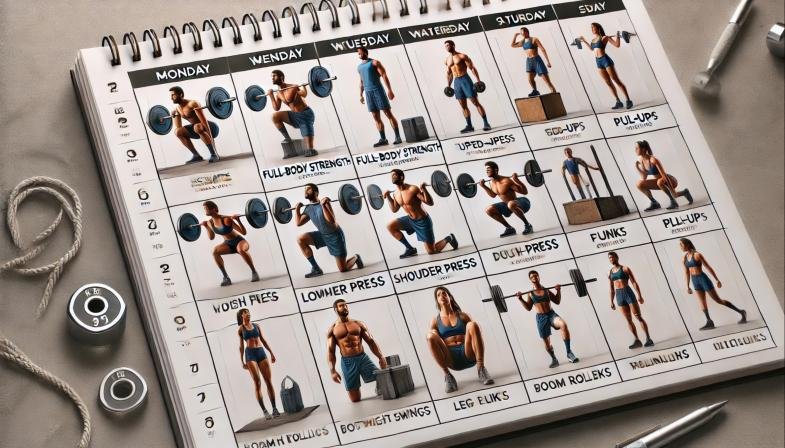If you’re looking to lose weight effectively, you might think that cardio is your best bet. While running, cycling, and HIIT workouts do burn calories, strength training is an equally—if not more—powerful tool for long-term fat loss.
Strength training doesn’t just help you build muscle; it boosts metabolism, enhances fat burn, and improves overall body composition. In this expert-backed guide, we’ll break down everything you need to know about strength training for weight loss, including its benefits, the best exercises, and how to structure your workouts for maximum results.
Why Strength Training is Essential for Weight Loss
Unlike traditional cardio workouts that burn calories only during the exercise, strength training offers a longer-lasting calorie burn. This is because:
Muscle Burns More Calories Than Fat – The more muscle you have, the higher your resting metabolic rate (RMR), meaning you burn more calories even while resting.
Increases Afterburn Effect (EPOC) – Strength training creates an “afterburn” effect, scientifically known as Excess Post-Exercise Oxygen Consumption (EPOC). This means your body continues to burn calories for hours after your workout.
Enhances Body Composition – Unlike crash diets that cause muscle loss, strength training preserves lean muscle while reducing fat, leading to a toned and defined physique.
Improves Insulin Sensitivity – Strength training helps regulate blood sugar levels, reducing the risk of weight gain and conditions like diabetes.
How to Structure a Strength Training Program for Weight Loss

To lose fat and build muscle, your strength training routine should include:
- Full-Body Workouts (to maximize calorie burn)
- Compound Movements (to engage multiple muscle groups)
- Progressive Overload (to ensure continuous improvement)
- Adequate Recovery (to avoid burnout and muscle fatigue)
Best Strength Training Exercises for Fat Loss
Here’s a science-backed list of the most effective strength training exercises for weight loss:
1. Squats – The King of Lower Body Training

- Muscles Worked: Quads, hamstrings, glutes, core
- Calories Burned: ~200-250 per 30 minutes
- Why It Works: Squats engage large muscle groups, boosting metabolism and enhancing lower body strength.
Pro Tip: Add weights (dumbbells, kettlebells, or a barbell) to increase resistance and calorie burn.
2. Deadlifts – The Ultimate Fat-Burning Compound Lift

- Muscles Worked: Back, glutes, hamstrings, core, forearms
- Calories Burned: ~250-350 per 30 minutes
- Why It Works: Deadlifts activate nearly every muscle, making them a high-impact calorie-burning movement.
Pro Tip: Maintain proper form to avoid injury—keep your back straight and engage your core.
3. Push-Ups – The No-Equipment Upper Body Builder

- Muscles Worked: Chest, shoulders, triceps, core
- Calories Burned: ~150-200 per 30 minutes
- Why It Works: Push-ups build upper body strength and endurance while also engaging the core.
Pro Tip: For extra difficulty, try decline push-ups or weighted push-ups.
4. Lunges – Balance, Strength & Fat Loss Combined

- Muscles Worked: Quads, hamstrings, glutes, calves, core
- Calories Burned: ~200-250 per 30 minutes
- Why It Works: Lunges improve balance, target multiple leg muscles, and enhance overall endurance.
Pro Tip: Add dumbbells or a barbell for extra resistance.
5. Pull-Ups – The Ultimate Upper Body Test

- Muscles Worked: Back, biceps, shoulders, core
- Calories Burned: ~200-300 per 30 minutes
- Why It Works: Pull-ups build functional strength, tone the upper body, and burn a significant amount of calories.
Pro Tip: If you’re a beginner, use an assisted pull-up machine or resistance bands to build strength.
6. Kettlebell Swings – Cardio & Strength in One Move

Muscles Worked: Glutes, hamstrings, core, shoulders
Calories Burned: ~400-600 per 30 minutes
Why It Works: Kettlebell swings are a high-intensity exercise that combines cardio and strength, making them one of the best moves for weight loss.
Pro Tip: Start with a light kettlebell (15-20 lbs) and focus on proper hip thrusting motion.
How to Design a Weekly Strength Training Plan

For optimal fat loss and muscle building, follow this expert-approved weekly strength training split:
| Day | Workout Focus | Key Exercises |
|---|---|---|
| Monday | Full-Body Strength | Squats, Deadlifts, Push-Ups, Pull-Ups |
| Tuesday | Active Recovery | Light Cardio, Yoga, Stretching |
| Wednesday | Upper Body Strength | Bench Press, Rows, Shoulder Press, Bicep Curls |
| Thursday | Lower Body & Core | Lunges, Deadlifts, Leg Press, Planks |
| Friday | Functional & HIIT | Kettlebell Swings, Box Jumps, Battle Ropes |
| Saturday | Full-Body Circuit | Bodyweight Exercises, Dumbbell Workouts |
| Sunday | Rest & Recovery | Foam Rolling, Mobility Work |
- Aim for 3-5 strength training sessions per week
- Combine with high-protein nutrition for best results
- Track progress by increasing weight or reps over time
Also read | Effective Belly Fat Workouts You Can Do at Home
Common Strength Training Myths & The Truth
Myth 1: Strength Training Makes Women Bulky
Fact: Women have lower testosterone levels, making it impossible to bulk up like men. Instead, strength training creates a lean and toned look.
Myth 2: Lifting Weights Stops Fat Loss
Fact: Strength training accelerates fat loss by increasing muscle mass and metabolism.
Myth 3: More Reps = More Fat Burn
Fact: Lower reps with heavy weights burn more fat long-term due to the increased muscle-building effect.
Final Thoughts
Strength training is not just for bodybuilders—it’s one of the most effective methods for long-term weight loss, muscle definition, and overall health improvement. By incorporating compound movements, progressive overload, and a structured workout plan, you can torch fat, build strength, and transform your body.
Whether you’re a beginner or an advanced lifter, consistency and proper nutrition are key. Start lifting today and watch your fitness journey take off.
Suggested reads: Kettlebell Burpee Workout: The Ultimate Full-Body Fat-Blasting Exercise










